ITEM SUCCESSFULLY ADDED TO CART
LEARNING CENTER
DIAMONDS
The hardest, rarest, densest natural substance known to man.
A precious gemstone composed of pure Carbon.
A diamond's quality is rated in accordance with the Four C's: Cut, Color, Clarity and Carat Weight.
While Africa is known as the Diamond continent, it is actually in Australia that the largest reserves are to be found - including the very rare and highly valued pink and red fancy colored diamonds.
Diamond is the birthstone for April.
SHAPES
There are eight common diamond shapes.
They are round, marquise, pear, oval, heart, princess/radiant, emerald, and trillion.
The round is the most popular (the rest are called fancy-shaped).
There are also other shapes created and sold by manufacturers.
 |
 |
 |
 |
| Round | Oval | Marquise | Pear |
 |
 |
 |
 |
| Princess | Heart | Emerald | Trillion |
CUT
How well a diamond is cut has a lot to do with the stone's fire and brilliance.
Brilliance describes the reflections of white light coming from the diamond.
A diamond that is cut either too shallow or too deep will not be as brilliant as a properly cut diamond.
Cut should not be confused with shape. To learn about diamond shapes, see above.


COLOR
Diamonds are graded according to the GIA color chart. The letters D through
Z are used to designate a diamond's color with D being colorless and Z-graded stones having a lot of color.
Most often thought of as a colorless stone, diamonds also come in a rainbow of fancy colors.
Fancy diamonds are very rare, valuable and sought after by collectors.
Color Rating Chart
Color Grading Scale
Color Rating Chart
|
|
|
D E F | G H I J | K L M | N O P Q R | S T U V W X Y Z |
|
|
|
|
|
Colorless | Near Colorless | Faint Yellow | Very Light Yellow | Light Yellow |
|
|
Color Grading Scale
| AGS | 0 | .5 | 1.0 | 1.5 | 2.0 | 2.5 | 3.0 | 3.5 | 4.0 | 4.5 | 5.0 | 5.5 | 6.0 | 6.5 | 7.0 | 7.5 | 8.0 | 8.5 | 9.0 | 9.5 | 10.0 | Fancy Yellow |
||
| GIA | D | E | F | G | H | I | J | K | L | M | N | O | P | Q | R | S | T | U | V | W | X | Y | Z | Fancy Yellow |
| Colorless | Near Colorless | Faint Yellow | Very Light Yellow | Light Yellow | ||||||||||||||||||||
CLARITY
Clarity refers to the internal clearness or purity of the diamond.
Gemstones with the highest clarity contain few or no inclusions (imperfections) in the stone's crystalline structure.
Clarity is graded with a 10x magnifier.
The clarity rating of a diamond ranges from FL (flawless) to I (inclusions visible to the naked eye).
| IF | VVS1 - VVS2 | VS1 - VS2 | SI1 - SI2 | I1 - I3 |
| Internally flawless, no natural characteristics visible under 10x magnification. Extremely rare. | Minute characteristics, extremely hard to see even under 10x magnification. Extremely rare. | Very minor characteristics. Difficult to see even with magnification. | Slight characteristics that can be seen under 10x magnification. | Characteristics are visible to the naked eye. |
 |
 |
 |
 |
 |
CARAT WEIGHT
A very accurate unit of weight used for gemstones. The word Carat is derived from the Carob seed, which was used in the days of antiquity as counterweights on scales for small measurements because Carob seeds were extremely similar in weight.
The weight of a diamond is measured in carats. Total carat weight (T.W.) is the total weight of all the stones in a piece of jewelry. One carat is equal to 100 points. The term carats is often confused with "Karats". "Karat" is a measurement of gold purity and has no relationship to the term Carats.
The price per carat rises dramatically as the diamond increases in size, simply because larger diamonds are rarer, and found less frequently.
Diamonds of the same carat weight vary widely in price, because of other factors that include clarity, cutting or proportion, and color.
PROPER CARE FOR YOUR DIAMOND
A little time and effort on your part will keep your diamond looking new from the day you purchase it. By having your diamond set in a relatively protective setting, and remaining conscious of it on your finger, you can keep your diamond intact for a lifetime.
The most important steps to care for your diamond include:
Periodically inspect your diamond and setting for weakness or damage and take it to a professional jeweler for immediate repair if you notice any deterioration. Once a year, it is a good idea to have your diamond cleaned by a professional and have the security of the setting checked.
The most important steps to care for your diamond include:
- Make sure that all jewelry is removed during rough work or when handling harsh chemicals. Exposure during ordinary wear to perspiration and household chemicals, like chlorine and hairspray, can cause buildup that dulls the surface of a diamond.
- It is generally best to clean your jewelry with warm water, mild soap (not detergent), and a soft toothbrush. Rinse under warm running water and pat dry with a soft, lint-free cloth.
- Store it in a soft cloth pouch away from other pieces to prevent the diamond or diamonds from getting scratched or dulling other jewelry.
Periodically inspect your diamond and setting for weakness or damage and take it to a professional jeweler for immediate repair if you notice any deterioration. Once a year, it is a good idea to have your diamond cleaned by a professional and have the security of the setting checked.
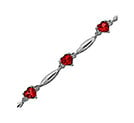 Bracelets
Bracelets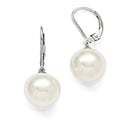 Earrings
Earrings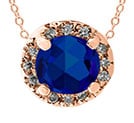 Necklaces & Pendants
Necklaces & Pendants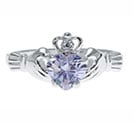 Rings
Rings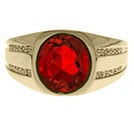 Men's Jewelry
Men's Jewelry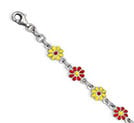 Children's Jewelry
Children's Jewelry











